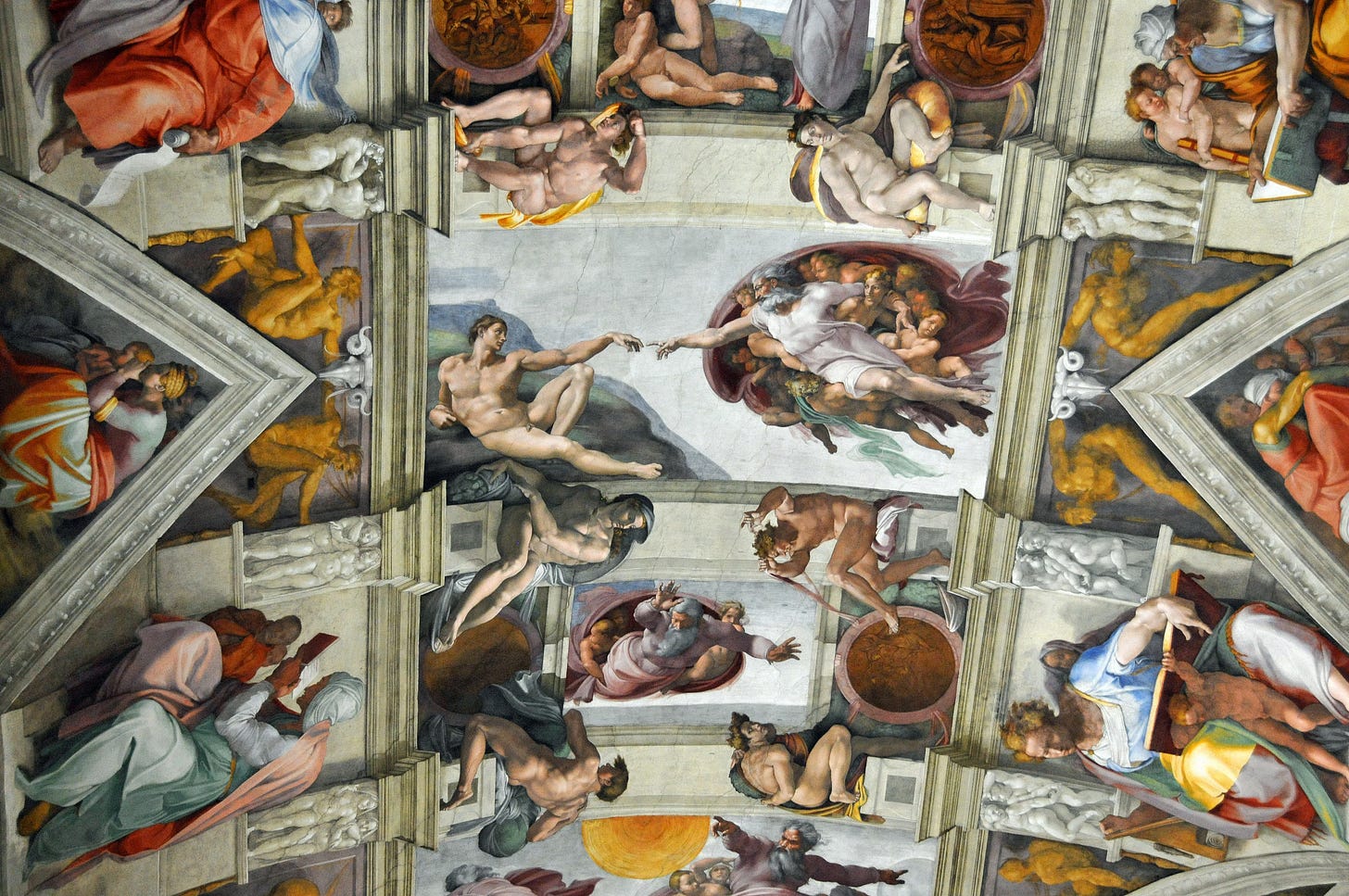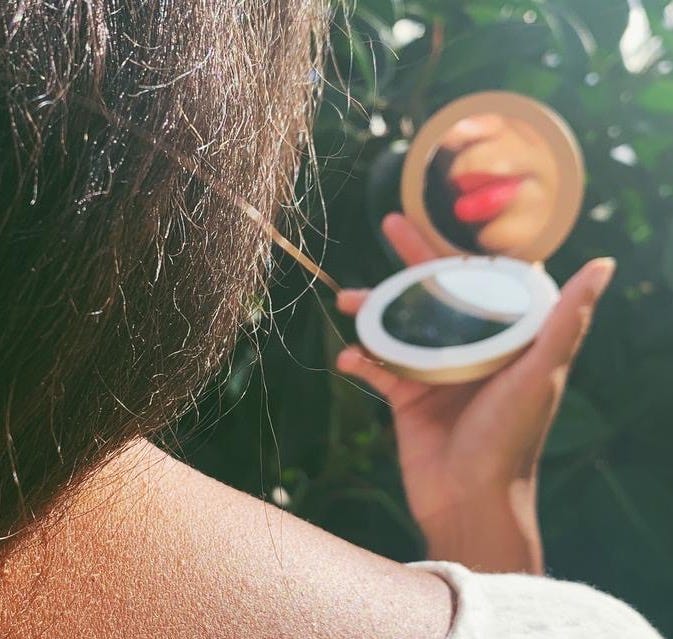The Gist is my take on what’s shaping us and our world: high-level, direct, and, as one reader put it, “Delightfully Distilled”.
Subscribe so you don’t miss a gist.
We live in a world obsessed with appearances but the longing for beauty runs far deeper than aesthetics.
Basically there can be no categories such as ‘religious’ art and ‘secular’ art, because all true art is incarnational, and therefore ‘religious.’
Madeleine L’Engle
How We Got Here
In the beginning, our Creator formed the cosmos and everything in it with intention and beauty.
The world could have worked without iridescent insect wings, or flecks of color in our eyes, or the way dew settles on flower petals and blades of grass.
But God didn’t design the world just to be inhabitable; He designed it to sing.
Let the rivers clap their hands;
let the hills sing for joy together before the Lord
Psalm 98:8-9a
Then shall all the trees of the forest sing for joy before the Lord
Psalm 96:12-13a
God designed our world to sing a song that could lead us home if we listen to it.
They know the truth about God because he has made it obvious to them. For ever since the world was created, people have seen the earth and sky. Through everything God made, they can clearly see his invisible qualities—his eternal power and divine nature. So they have no excuse for not knowing God.
Romans 1:19-20

For centuries, both art and science were understood as ways to discover and reflect the mind of God. The physical world was not separate from the spiritual but a means of revealing it. Johannes Kepler, writing equations that describe planetary motion, said he was “merely thinking God’s thoughts after Him.” Isaac Newton saw his scientific work as inseparable from theology and devoted as much time to studying Scripture as he did to physics. The impulse to study the world wasn’t a rebellion against belief; it was belief in action.
Art, architecture, and music have long been recognized as forms of spiritual expression and even garments were created with sacred meaning for sacred duties. During the Renaissance, a resurgence of Neoplatonism that morphed into Christian Platonism, helped recover the idea that beauty was a reflection of the divine, that contemplating beauty could draw the soul closer to God.
“The soul, remembering the divine beauty it once saw, is excited by these present beauties as by resemblances of that divine beauty,”
Italian philosopher, priest and translator, Marsilio Ficino wrote in his Commentary on Plato's Symposium
And on the other side of the world, the works of artists like Zen monk and painter Sesshū Tōyō were said to be not merely painted things, but spiritual creations. From Italy to Japan, though the religions differed, the idea was the same: beauty was not merely a subjective human idea. It was communion with the divine, collaboration of the created with the Creator.
Beauty was inherently revelation, not just decoration.
But over time, something shifted. As the Enlightenment emphasized reason and the Romantic era elevated emotion, Truth became individual and fragmented. By the modern era, art was all but divorced from transcendence, and science was severed from soul. Beauty became a matter of personal taste that shifted with culture. Knowledge became neutral data. The sacred was relegated to the explicitly “religious”.
The net result is like trying to cut pretty flowers from their vine to put in a vase, separating beauty from what gives it life. Severed beauty may still impress for a while, but it will wilt, decay, and lose power. Only nourished, connected beauty — rooted in the divine source — can endure and bear fruit. Sound familiar? Some concepts are universal.
Why It Matters
Beauty isn’t confined to galleries or grand halls. It’s everywhere. It affects why we choose one coffee mug over another, why a couch “feels right” in our living room, why we double-tap a post of cake or classic cars. The Met Gala trends like breaking news. Practically every town in America has a weekend arts market. We photograph a beautifully plated meal and share it online — because, broadly speaking, beauty pulls at us and makes us want to bring others close to it, too.
We live in the most image-saturated culture in history. We see thousands of images a day and we have to always be prepared to be seen as well. We’re not just consuming through the constant advertising machines of social media — we’re pressured to produce, too. And while we might dismiss socials as shallow, I think it reveals something deep: beauty holds power.
Good, beautiful design is persuasive. We’re wired to be influenced by good design and businesses capitalize on this. That’s why you walk into Target for dish soap and leave with a candle, a faux plant, and (another) throw pillow. How did they get you again? Beauty.
The commercialization of beauty has made us suspicious of it, like it’s vain or wrong or unnecessary. We’re confused about how to value it. Beauty influencers will tell you how to contour your nose in one video and in the next, complain about beauty standards. Actresses will model for anti-aging face creams and then give an interview bemoaning the focus on women’s appearance on the red carpet (which they spent 4 hours in a chair getting ready for!). Our culture tells us beauty is everything and nothing, to be celebrated and scorned.
But we all get dressed; literally and metaphorically. We all engage with commercialized beauty every day and express ourselves with it whether it’s a beach bag, a phone case or a lipstick color. The question is: do we know what we’re expressing? Because if we can’t define beauty, we’re vulnerable to someone else doing it for us.
So, Treat Beauty Like It Matters.
When beauty stops you in your tracks, don’t dismiss it as “worldly”. If beauty isn’t neutral then we can’t afford to treat it like it’s trivial.
Just because modern culture tries to secularize beauty, severing it from its source and selling it back to us as mere human taste, doesn’t mean we have to go along with it.
We are called not to be conformed to the pattern of this world, but to be transformed by the renewing of our minds (Romans 12:2). That doesn’t mean rejecting every fashion or artistic trend; it means refusing to treat beauty as merely subjective. It means recognizing that a well-cut dress, a moving film, or a striking work of art can start a conversation, one that points us toward Divine Beauty and objective Truth.
We can take beauty seriously, not just sentimentally. We can restore it. With a Kingdom perspective, we can refuse to let the world dictate what beauty is, why it matters, or who gets the credit.
That also doesn’t mean every lovely thing has to change your life or move you to tears. It would be exhausting to live like that! It simply means you don’t ignore the Voice behind it. You don’t look at manifestations of the Creator and call it empty.
So, here’s my challenge to you. When something beautiful moves you, recognize that sacred impulse that’s calling to you.
Let beauty remind you of the One who made it all.
Thank God for beauty and for the gift of being designed to enjoy it; recognizing that your ability to perceive beauty comes from Him.
Make beautiful things. Build, write, design, create as an offering and a tribute to the Maker of All Beautiful Things.
Choose beauty. From your daily silverware to what you wear to the grocery store, make meaningful choices that invite conversation and reminders.
Teach your children that beauty belongs to God. Enjoying it and creating it can be acts of worship when you do it as unto the Lord (Colossians 3:23–24).
Know that Beauty is not a distraction or mere decoration. It’s a signpost, pointing us to the Creator of All Beauty.
Here's the Bottom Line
Dostoyevsky once wrote, “Beauty will save the world.”
But he also warned:
“Beauty is a fearful and terrible thing! Fearful because it’s undefinable, and it cannot be defined, because here God gave us only riddles. Here the shores converge, here all contradictions live together... The terrible thing is that beauty is not only fearful but also mysterious. Here the devil is struggling with God, and the battlefield is the human heart.”
While these sentiments are from works of fiction, I think he was right in reality.
Beauty is not neutral. It’s powerful. It can lead us toward vanity, covetousness, or soulless sensuality. Or it can lead us toward wonder, toward worship, toward the grandeur of God’s nature. It depends on whether we stop at the surface, or trace it back to the source.
We reclaim beauty by remembering that it’s not ours, it’s God’s.
Let it pull you upward as an invitation.
Let each brush with beauty bring you home.
Further Reading - books that influenced this Gist
Saving Leonardo: A Call to Resist the Secular Assault on Mind, Morals, and Meaning by Nancy Pearcey
Mind of the Maker: The Expression of Faith through Creativity and Art by Dorothy L. Sayers
Walking on Water: Reflections on Faith and Art by Madeleine L’Engle
Every Moment Holy: Volume 1, especially the Momentary Liturgies for Practicing the Presence of God which includes a liturgy titled “Upon Seeing a Beautiful Person”.




